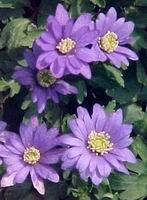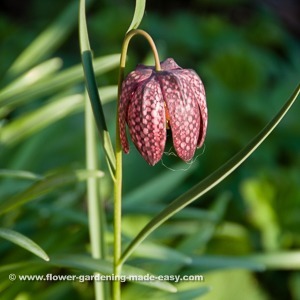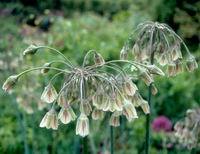There are many unusual spring bulbs that are well worth growing, in addition to the tulips and daffodils that most people know.
Some of these less common bulbs are small and delicate, others tall and exotic looking, but all are fabulous. Many naturalize to come back year after year, spreading if they’re happy, and most are unappealing to bulb menaces such as deer and squirrels.
Uncommon spring-flowering bulbs to discover
These unusual spring bulbs are perfect way to add something different to your spring show.
Blue star windflower (Anemone blanda):

Windflower
(Anemone blanda)
Photo: © Y. Cunnington
These attractive, low-growing daisy-like blue, pink or white flowers with yellow centers are as cute as a button and grow about an inch or two wide. Windflowers grow about 5 or 6 inches tall and bloom in mid-spring.
These unusual spring bulbs are actually rhizomes that have a tendency to dry out, so it’s a good practice to soak them in water overnight to plump up with moisture before planting. Plant about 2 inches deep and 1 or 2 inches apart. Use at least 12 to 15 per clump.
They make a lovely spring show under flowering shrubs or at the front edge of a perennial bed. This plant naturalizes well. By the way, the name is derived from the Greek word for ‘wind’ (anemos) and ‘blanda’ meaning ‘beautiful’.
Snake’s-head fritillaria or guinea-hen flower (Fritillaria meleagris):

Fritillaria meleagris
This species of fritillaria has purple or white nodding flowers with unusual chequered petals about a inch or two wide that bloom in early spring.
These unusual spring bulbs grow about 10 inches tall and are native to Europe where they usually grow in moist locations.
They prefer rich soil that doesn’t dry out. Plant them 4 inches deep and 3 or 4 inches apart and use about 9 to 13 bulbs in each clump. Try to get them into the ground as early as possible in the fall, as they can dry out easily.
Fritillaria looks lovely in flower beds, rock gardens, and under trees and shrubs.
Bulgarian ornamental onion (Nectaroscordum siculum):

Nectaroscordum siculum
These eye-catching unusual spring bulbs have gorgeous opalescent dangling bell-shaped flowers that bloom in late spring on top of 35 inch tall stems.
The bulbs should be planted 8 inches deep and 8 inches apart in very well drained soil. Plant in clumps of at least 3 to 5 bulbs.
Nectaroscordum looks wonderful with hostas. I once saw them interplanted with a collection of hostas so that the bulb flowers gave the impression that the hostas were blooming in late spring.
Persian fritillaria (Fritillaria persica):
This plant has deep purple, almost black, nodding flowers atop 30 inch tall stems in early spring, and blue-green leaves that are also very attractive.
These unusual spring bulbs are quite large and should be planted as early in fall as possible because their roots can start to grow inside the packaging and be easily damaged during planting. This species also likes a well-drained soil. Plant 10 inches deep and 10 inches apart.
Fritillaria persica looks lovely planted with yellow or white daffodils or in the flower garden between clumps of perennials. Plant at least three to a grouping.
Wild hyacinth (Camassia species):
Although these spring bulbs are native to western North America, they aren’t at all well-known in the U.S. and Canada.
There are several species and what they all have in common are upright spikes of white, or more commonly, light or dark blue star-like flowers. They bloom in late spring to early summer and like moister soil than most bulbs.
Camassia quamash (sometimes listed as C. esculenta) have deep blue flowers and grow about 14 to 16 inches tall. Plant about 6 inches deep and 8 inches apart. North American native people used to eat these bulbs.
Camassia cusickii have light blue flowers in late spring to early summer but grow taller, about 24 to 30 inches. Plant 6 inches and 8 inches apart. This species produces abundant flowers, with up to 100 star-shaped little flowers on each raceme.
Camassia leichtlinii is another tall-growing species. There are two cultivars: ‘Alba’, which blooms in white, and ‘Caerulea’, light blue. Like the others, plant this one 6 inches deep and 8 inches apart. Wild hyacinths combine well with perennials such as daylilies, peonies, Siberian iris or bleeding heart.
More Plants for Spring
For spring drama, try black tulips
Snowdrops, delicate, but tough harbingers of spring
Naturalizing with spring bulbs
Cushion spurge, a perennial to go with bulbs




